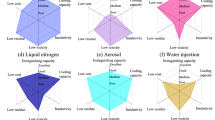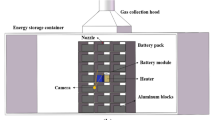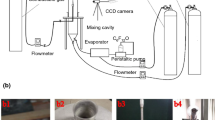Abstract
Under abusive conditions, lithium-ion battery (LIB) are prone to thermal runaway (TR), which can result in fire and explosion, even toxic. A water-in-oil dodecafluoro-2-methylpentan-3-one (C6F12O) microemulsion was created in this study by emulsifying C6F12O as the oil phase with a fluorocarbon surfactant, sodium perfluorooctanoate, and a co-surfactant, perfluorobutanol, and encapsulating the aqueous phase. In this paper, the combustion characteristics of 100% SOC LIB and the fire extinguishing experiments of various inhibitors such as microemulsions were carried out; the flame suppression effect, cooling effect and suppression of TR gas production effect of different extinguishing agents were explored; the synergistic suppression mechanism of C6F12O microemulsions on LIB fires was revealed. The experimental results show that C6F12O microemulsions can quickly and effectively extinguish LIB flames after release, and their fire extinguishing time is short, which can effectively reduce the generation of high temperature battery fumes and prevent battery re-ignition without short circuit risk. The microemulsion PM1 (61.2% C6F12O, 26.5% water, and the rest emulsifiers) was the most effective: compared with C6F12O and water, the cooling efficiency was enhanced by 156% and 28%, respectively, and the degree of TR inhibition was enhanced by 18.5% and 24.0%; and the release of cell gas production during inhibition was reduced.











Similar content being viewed by others

References
Poizot P, Dolhem F. Clean energy new deal for a sustainable world: from non-CO2 generating energy sources to greener electrochemical storage devices. Energy Environ Sci. 2011;4:2003–19.
Ni S, Tan S, An Q, Mai L. Three dimensional porous frameworks for lithium dendrite suppression. J Energy Chem. 2020;44:73–89.
Ohsaki T, Kishi T, Kuboki T, Takami N, Shimura N, Sato Y, Sekino M, Satoh A. Overcharge reaction of lithium-ion batteries. J Power Sources. 2005;146:97–100.
Ye J, Chen H, Wang Q, Huang P, Sun J, Lo S. Thermal behavior and failure mechanism of lithium ion cells during overcharge under adiabatic conditions. Appl Energy. 2016;182:464–74.
Kitoh K, Nemoto H. 100 Wh large size Li-ion batteries and safety tests. J Power Sour. 1999;81:887–90.
Wu T, Chen H, Wang Q, Sun J. Comparison analysis on the thermal runaway of lithium-ion battery under two heating modes. J Hazard Mater. 2018;344:733–41.
Wang Q, Ping P, Zhao X, Chu G, Sun J, Chen C. Thermal runaway caused fire and explosion of lithium ion battery. J Power Sour. 2012;208:210–24.
Ji H, Chung Y-H, Pan X-H, Hua M, Shu C-M, Zhang L-J. Study of lithium–ion battery module’s external short circuit under different temperatures. J Therm Anal Calorim. 2021;144:1065–72.
Wang Y-W, Shu C-M. Energy generation mechanisms for a Li-ion cell in case of thermal explosion: a review. J Energy Storage. 2022;55:105501.
Liu P, Li Y, Mao B, Chen M, Huang Z, Wang Q. Experimental study on thermal runaway and fire behaviors of large format lithium iron phosphate battery. Appl Therm Eng. 2021;192:116949.
Kim SW, Park SG, Lee EJ. Assessment of the explosion risk during lithium-ion battery fires. J Loss Prev Process Ind. 2022;80:104851.
Wang K, Cao Y, Yang Y, Wang Z, Ouyang D. Exploring fluorinated electrolyte for high-voltage and high-safety Li-ion cells with Li(Ni0.8Mn0.1Co0.1)O2 cathode. Int J Energy Res. 2022;46:24243–53.
Ribière P, Grugeon S, Morcrette M, Boyanov S, Laruelle S, Marlair G. Investigation on the fire-induced hazards of Li-ion battery cells by fire calorimetry. Energy Environ Sci. 2012;5:5271–80.
Peng Y, Yang L, Ju X, Liao B, Ye K, Li L, Cao B, Ni Y. A comprehensive investigation on the thermal and toxic hazards of large format lithium-ion batteries with LiFePO4 cathode. J Hazard Mater. 2020;381:120916.
Larsson F, Andersson P, Blomqvist P, Mellander B-E. Toxic fluoride gas emissions from lithium-ion battery fires. Sci Rep. 2017;7:1–13.
Can A, Selimefendigil F, Öztop HF. A review on soft computing and nanofluid applications for battery thermal management. J Energy Storage. 2022;1(53):105214.
Zhou Y, Bu R, Gong J, Zhang X, Fan C, Wang X. Assessment of a clean and efficient fire-extinguishing technique: continuous and cycling discharge water mist system. J Cleaner Prod. 2018;182:682–93.
Zhou Y, Bu R, Zhang X, Fan C, Gong J. Performance evaluation of water mist fire suppression: a clean and sustainable fire-fighting technique in mechanically-ventilated place. J Cleaner Prod. 2019;209:1319–31.
Cui Y, Liu J. Research progress of water mist fire extinguishing technology and its application in battery fires. Process Saf Environ Prot. 2021;149:559–74.
Xu J, Duan Q, Zhang L, Liu Y, Sun J, Wang Q. The enhanced cooling effect of water mist with additives on inhibiting lithium ion battery thermal runaway. J Loss Prev Process Ind. 2022;77:104784.
Egelhaaf M, Kress D, Wolpert D, Lange T, Justen R, Wilstermann H. Fire fighting of Li-Ion traction batteries. SAE Int J Altern Powertrains. 2013;2:37–48.
Yuan S, Chang C, Zhang J, Liu Y, Qian X. Experimental investigation of a micelle encapsulator F-500 on suppressing lithium ion phosphate batteries fire and rapid cooling. J Loss Prev Process Ind. 2022;79:104816.
Xu J, Guo P, Duan Q, Yu X, Zhang L, Liu Y, Wang Q. Experimental study of the effectiveness of three kinds of extinguishing agents on suppressing lithium-ion battery fires. Appl Therm Eng. 2020;171:115076.
Zhang L, Duan Q, Liu Y, Xu J, Sun J, Xiao H, Wang Q. Experimental investigation of water spray on suppressing lithium-ion battery fires. Appl Therm Eng. 2021;120:103117.
Liu T, Liu Y, Wang X, Kong X, Li G. Cooling control of thermally-induced thermal runaway in 18,650 lithium ion battery with water mist. Energy Convers Manage. 2019;199:111969.
Zhao J, Xue F, Fu Y, Cheng Y, Yang H, Lu S. A comparative study on the thermal runaway inhibition of 18650 lithium-ion batteries by different fire extinguishing agents. iScience. 2021;24:102854.
Liu Y, Duan Q, Xu J, Chen H, Lu W, Wang Q. Experimental study on the efficiency of dodecafluoro-2-methylpentan-3-one on suppressing lithium-ion battery fires. RSC Adv. 2018;8:42223–32.
Wang Q, Shao G, Duan Q, Chen M, Li Y, Wu K, Liu B, Peng P, Sun J. The efficiency of heptafluoropropane fire extinguishing agent on suppressing the lithium titanate battery fire. Fire Technol. 2016;52:387–96.
Zhang L, Li Y, Duan Q, Chen M, Xu J, Zhao C, Sun J, Wang Q. Experimental study on the synergistic effect of gas extinguishing agents and water mist on suppressing lithium-ion battery fires. J Energy Storage. 2020;32:101801.
Koch S, Fill A, Birke KP. Comprehensive gas analysis on large scale automotive lithium-ion cells in thermal runaway. J Power Sour. 2018;398:106–12.
Yuan L, Dubaniewicz T, Zlochower I, Thomas R, Rayyan N. Experimental study on thermal runaway and vented gases of lithium-ion cells. Process Saf Environ Prot. 2020;144:186–92.
Somandepalli V, Marr K, Horn Q. Quantification of combustion hazards of thermal runaway failures in lithium-ion batteries. SAE Int J Altern Powertrains. 2014;3:98–104.
Zhang L, Duan Q, Meng X, Jin K, Xu J, Sun J, Wang Q. Experimental investigation on intermittent spray cooling and toxic hazards of lithium-ion battery thermal runaway. Energy Convers Manag. 2022;252:115091.
Lecocq A, Eshetu GG, Grugeon S, Martin N, Laruelle S, Marlair G. Scenario-based prediction of Li-ion batteries fire-induced toxicity. J Power Sour. 2016;316:197–206.
Larsson F, Andersson P, Blomqvist P, Lorén A, Mellander B-E. Characteristics of lithium-ion batteries during fire tests. J Power Sour. 2014;271:414–20.
Larsson F, Bertilsson S, Furlani M, Albinsson I, Mellander B-E. Gas explosions and thermal runaways during external heating abuse of commercial lithium-ion graphite-LiCoO2 cells at different levels of ageing. J Power Sour. 2018;373:220–31.
Zhou Y, Bai J, Wang Z, Wang J, Bai W. Inhibition of thermal runaway in lithium-ion batteries by fine water mist containing a low-conductivity compound additive. J Cleaner Prod. 2022;340:130841.
Acknowledgements
This work was supported by the National Key Research and Development Program of China [grant number 2017YFC0804700].
Author information
Authors and Affiliations
Contributions
YL: Conceptualization, Investigation, Validation, Formal analysis, Writing-original draft; CC: Validation, Data Curation, Investigation; SL: Investigation, Data Curation; JZ: Investigation; SY: Investigation; KW: Investigation; MY: Investigation; XQ: Conceptualization, Methodology, Project administration, Supervision; QX: Writing-review and editing, Supervision.
Corresponding authors
Ethics declarations
Competing interest
The authors declare that they have no known competing financial interests or personal relationships that could have appeared to influence the work reported in this paper.
Additional information
Publisher's Note
Springer Nature remains neutral with regard to jurisdictional claims in published maps and institutional affiliations.
Rights and permissions
Springer Nature or its licensor (e.g. a society or other partner) holds exclusive rights to this article under a publishing agreement with the author(s) or other rightsholder(s); author self-archiving of the accepted manuscript version of this article is solely governed by the terms of such publishing agreement and applicable law.
About this article
Cite this article
Liu, Y., Chang, C., Li, S. et al. Efficiency of dodecafluoro-2-methylpentan-3-one microemulsion to inhibit thermal runaway in lithium-ion batteries. J Therm Anal Calorim 148, 12891–12905 (2023). https://doi.org/10.1007/s10973-023-12554-x
Received:
Accepted:
Published:
Issue Date:
DOI: https://doi.org/10.1007/s10973-023-12554-x



